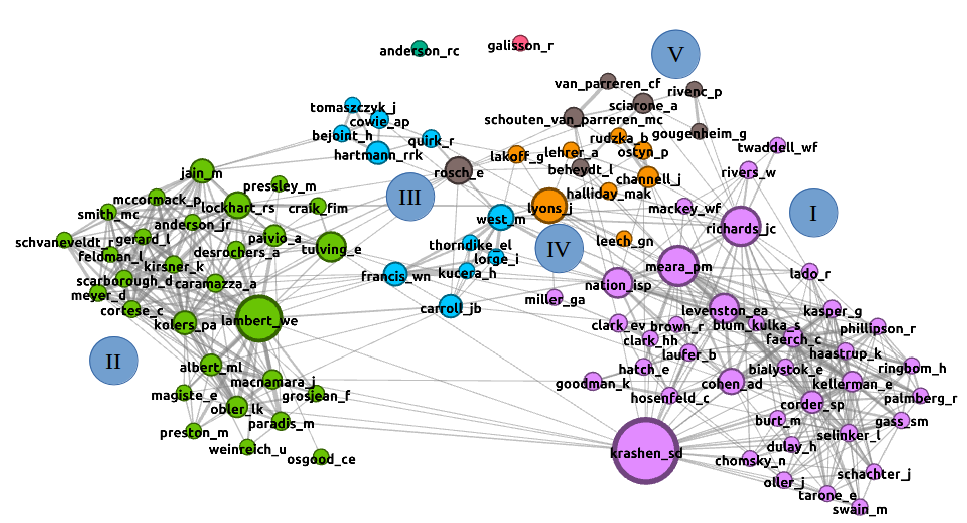 |
||
Lognostics Maps 1983-87 |
||

|
data source: VARGA 1983-867: data analysis November 2019 data: 355 papers, 94 nodes, 1320 co-citations, 5+2 clusters threshold for inclusion: Authors must be cited in at least ten different papers. Co-citations occurring less than four times are excluded. 3,816 unique sources are cited in the 1983-87 data set, with 94 sources cited in at least ten papers. The map shows the pattern of co-citations between these 94 most cited sources. The Sources are sized according to their betweenness centrality in the map. This measure gives prominence to sources who act as important links between the clusters, rather than to sources who are cited a lot within a single cluster. In this map, the most significant sources are Krashen, Lambert, Meara, Richards, Nation, Levenston, Tulving, Cohen, Lyons, and Rosch. Four of these sources are new entrants to the top ten significant sources list (Meara, Nation, Tulving, and Rosch), while four sources who were prominent in the 1982-1986 list have dropped out (Corder, Macnamara, Kolers and H Clark).
The analysis identifies five major clusters in the data, together with two singletons: Anderson was a detached singleton in the 1982-86 data set, and retains this status here. Galisson is a new singleton, a rare instance of French vocabulary research. These sources are frequently cited in this dat set, but not consistently co-cited with other sources.
Cluster I, the large cluster at the Eastern edge of the map is the core of the applied linguistics sources. Surprisingly, this cluster is still dominated by Krashen, who appears to act as the main linking node between this cluster and the psychologists in Cluster II. Levenston, Meara, and Richards continue to play a central role in this cluster, but significantly, they are joined by Nation who was previously identified with a different group of sources. This cluster now accounts for about 40% of the sources that make up the map. The main structural feature worth noting in this map is the broad split between linguists on the right of the map, and psychologists on the left. The linguists make up a much larger proportion of the significant influences in 1983-87, but their co-citations are much more varied than is the case for the psychologists. (There is a dense set of co-citations among the European sources in cluster I, but the other links in clusters I, II, IV and V are relatively weak. Richards, Meara and Nation provide most of the links between the linguistics clusters. Krashen's co-citations acount for nearly all of the links between cluster I and cluster IV, and he preserves his status as pre-eminent Influence in this data set.
|
(c) 2019 Paul Meara